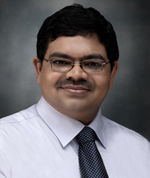| |
TRICO FELLOWS' FEEDBACK
|
|
| |
 |
|
Dr. Pushpendra Garg
TRICO Fellow
March 08 to September 08 |
| |
Q How did you become interested in the transradial approach?
I became interested in TRI when a patient asked that his angiography be performed through the transradial route.
He had learned about transradial intervention from a newspaper article written after Dr. Tejas Patel conducted a live workshop in our city.
The problem was that our group was only doing femoral approaches at the time!
I gave the patient some funny reason about why the femoral approach was preferred in his case, but his request for the radial approach haunted me.
Over the next two years, our group continued to experience all the usual complications of the femoral approach and we lost a few patients.
Then a friend attended the annual TRICO conference in Ahmedabad, India. He told me about the TRICO Fellowship and I applied.
Q What was the worst part about learning the transradial approach?
The worst part was my frustration with the first ten punctures. I succeeded on the eleventh! Dr. Patel and his team guided me all the way.
Now after completing the Fellowship, I feel I can handle the most difficult puncture and I know exactly what to do in the event of a rare complication. The Fellowship promised me 75 patients, but I was given 500 patients so I moved through the learning curve fast.
Q What has been the best part about learning the transradial approach?
I am proud to consider myself a hard-core radialist.
Recently when I punctured a very feeble radial artery in a patient in which the subclavian was filling through small collaterals — even then I was able to puncture. I wrote this case up for an Indian journal. I now feel I can use the radial approach for virtually all cases.
Q How has being a TRICO Fellow helped you?
It totally changed me. I am skilled and confident now. When facing a challenge, most operators switch to the femoral route. I have learned to face all challenges and cross all barriers. And I’m now performing even peripheral interventions through the radial route.
As a team, we average 15-20 TRI cases a day, often six or seven days a week.
Senior femoral interventionalists are now sending or losing their cases to me. The older guys are losing their patients to a young kid!
They will admit a patient, but once the patient finds out about TRI the patient will ask me to do it.
When others’ femoral patients see TRI patients up and walking about, they ask their doctors why they didn’t use the radial approach!
Q Why do many doctors hesitate or refuse to switch to the radial approach?
They are afraid of the time commitment required to move through the learning curve.
But today’s patients are demanding TRI.
Word of mouth is powerful. No patient wants a femoral stick if he can have the radial approach.
Q What do you wish could have been different?
I wish TRI would have been introduced in the curriculum of my cardiology fellowship. Then I would not have had to spend this extra time learning what I should have been taught in the first place.
Q What do your former femoral partners think of your becoming a dedicated radialist?
They want to learn TRI from me because more and more of their patients want the latest and the best.
Note: Dr. Garg is now an Associate with the TCVS Group. |
|
|
| |
 |
|
|